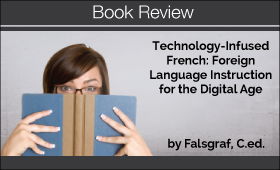Book Review: Technology-Infused French: Foreign language Instruction for the Digital Age by Falsgraf, C.ed.
 By Patricia Mosele, PhD, French instructor in the French & Italian department at the University of Colorado Boulder.
By Patricia Mosele, PhD, French instructor in the French & Italian department at the University of Colorado Boulder.
Falsgraf, C. ed. Technology-infused French: Foreign language instruction in the digital age. Eugene, OR: International Society for Technology in Education, 2011. ISBN 978-1-56484-282-4. Pp. ix+168. $26.95.
Teachers and world language teacher educators alike will welcome this thoughtfully written two-pronged approach to teaching French with technology. In addition to an entire first section on strategies, the book features a second section that contains practical examples of technology-enhanced teaching units designed around authentic cultural content. Four appendices provide assessment rubrics for each of the units along with lists of resources that teachers can use to create their own technology-enhanced lessons. A companion CD contains activities, handouts, and assessment rubrics in digital format. While written with the K-12 educational community in mind, the book and CD will also appeal to college and university French language instructors.
Section 1 provides a theoretical foundation for the thematic units in the second half of the book. Carl Falsgraf argues for using learner-friendly technological tools to develop proficiency through content-based learning. Karl Ennis outlines a plan that incorporates technology to support performance-based assessment and the National Standards for Foreign Language Learning. Rita Oleksak and Kathleen Riordan review a case study regarding the important role technology played in improving instruction and assessment in support of one district’s goal “to provide students the opportunity to become proficient in at least one language in addition to their first so that they become full citizens of the United States and of the global society” (p. 44).
Section 2 offers four complete thematic units, each based on an aspect of Francophone culture. The first two units, which target middle and high school learners, were created by secondary teachers working at the Center for Advanced Research on Language Acquisition (CARLA) at the University of Minnesota. Unit 1 treats Le Moyen-Âge en France (The Middle Ages in France) and Unit 2, Les Stéréotypes des Français (Stereotypes of the French). Unit 3, titled, “Carole Fredericks: Music is Only the Beginning,” and Unit 4, “The Culture and Literature of Francophone West Africa,” target high school through post-secondary learners and were created by high school teachers working at the National K-12 Foreign Language Resource Center (NLFRC) at Iowa State University. These unit designs illustrate how technology and thematic teaching can be seamlessly integrated to create authentic individualized language learning for students.
In all four content-based units, technology is a tool used to give students access to French language websites, news outlets, video, music, and more. Each features tightly integrated standards-based language learning and technology objectives and lists the hardware and software needed. These units also feature full implementation instructions, incorporating enough sequenced activities for two complete weeks of class, along with tips for extending the experience. Finally, there are formative and summative assessment rubrics in Appendix A and on the CD.
Overall, Technology-Infused French provides useful strategies and well designed practices that French teachers can use immediately in secondary and early post-secondary classrooms. Clearly, by creating pedagogically sound content-based lessons enhanced by technology, contributors to the book have made it possible for the rest of us to deliver instruction that is sure to make language learning more interesting, motivating, and meaningful for our students and ourselves!

